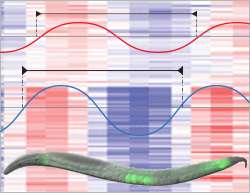A rhythm for development

Development of the nematode C. elegans is directed by rhythmic patterns of protein production. As Helge Grosshans and his team at the Friedrich Miescher Institute for Biomedical Research (FMI) have shown, oscillations with an 8-hour period occur across a wide variety of tissues, structures, cells and genes. The extent of the phenomenon suggests that the process involved could be a fundamental mechanism in the development of many organisms. The findings were published today in Molecular Cell.
Like the construction of a house, the development of an organism is a complex process requiring the assembly of numerous different structures. In the case of a construction site, materials are delivered at different times, so that the various structures can be assembled as simply and efficiently as possible in a clearly defined sequence. The research group led by Helge Grosshans at the FMI has now shown that, in the development of organisms, similar principles apply. Thus, the right building blocks are available at the right time, and chaos is avoided.
Rhythmic production patterns
The researchers showed that, in developing larvae of the nematode (roundworm) C. elegans, transcription of thousands of genes is subject to oscillations. Periodic transcription leads to rhythmic protein production, so that the proteins concerned are available when required. Although the various genes are transcribed at different times, the oscillation period is clearly defined, amounting to 8 hours in each case. As the molting of larvae exhibits the same periodicity, the oscillations certainly make sense for this aspect of their development.
Coordination in many tissues and organs
Particularly striking for the researchers, however, was the finding that the oscillations concern far more genes than are required for the control of molting or the molting process itself. Grosshans explains: "As we see oscillation with about a fifth of all transcripts, we believe we've discovered a mechanism that is important not just for molting, but for a much wider range of developmental processes." Accordingly, the oscillations are synchronized across the organism and occur at the same time in different tissues, organs and cells.
Model for control of development
On a much smaller scale, rhythmic gene expression is known to occur in mammalian development – e.g., in the formation of somites (primitive segments in the back of mammals which give rise to repetitive structures such as the vertebrae). However, as Grosshans points out: "There's no reason to suppose that biological oscillations are only suitable for the generation of repetitive structures. Rather, we believe this principle is widely applied in biology to coordinate the expression of different genes. So we're confident that the insights we've gained from the nematode will contribute to an improved understanding of more general developmental processes."
The researchers now plan to investigate the molecular machinery that controls these oscillations and induces the rapid rise and fall in gene expression.
More information: Hendriks G-J, Gaidatzis D, Aeschimann F, Grosshans H. (2014). "Extensive oscillatory gene expression during C. elegans larval development." Mol Cell, DOI: 10.1016/j.molcel.2013.12.013
Journal information: Molecular Cell

















